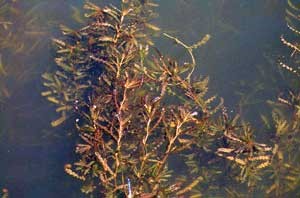Community News

Curly-leaf pondweed
Curly-leaf pondweed
(Potamogeton crispus)
Description: Curly-leaf pondweed has underwater leaves only. Mature stems may be several meters in length. The leaves of this plant are key to its identification. When visible, (they disintegrate early in the plant’s growth cycle) are slightly joined to the stem at the leaf base and 4 to 10 mm long. Flower spikes appear above the surface of the water from June through September.
Habitat: Curly-leaf pondweed is found in the underwater plant community. Generally preferring soft sediments, it grows in waters that are shallow or deep, still or flowing. Curly-leaf thrives where many other aquatic plants do not, for example in waters that are shaded, disturbed, polluted or turbid.
Annual Cycle: Curly-leaf pondweed, an aquatic perennial, is adapted to growing in cool conditions. Plants sprout in the late fall and grow through the winter, reaching maturity relatively early in the season (late spring through early summer). Flowers are produced during the growing season and the plants generally begin breaking up by mid-July. Curly-leaf pondweed produces seeds. Little is known, however, regarding the importance of seeds in the spread and reproduction of this plant.
Origin and U.S. Range: Curly-leaf pondweed is native to Eurasia. Introduced to the United States some time during the mid1800s, it has since spread to almost every state in the country. In addition to spread by natural causes and recreational activity, curly leaf pondweed has been planted intentionally for waterfowl and wildlife habitat, and possibly has been spread as a contaminant in water used to transport fish and fish eggs to hatcheries. Curly-leaf has infested West Pond in Parsonsfield in southern Maine and is currently present in the nearby states of New Hampshire, Massachusetts, Vermont, Connecticut, New York and Rhode Island.
Look a likes: May be confused with clasping-leaf pondweeds, large-leaf pondweed, red pondweed, variable pondweed, and white-stem pondweed.
